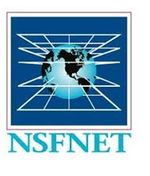National Science Foundation Network
 | |
| Type: | Research |
| Industry: | Internet |
| Founded: | 1985 |
| Founder(s): | National Science Foundation |
| Country: | USA |
| Website: | NSFNET |
The National Science Foundation Network (NSFNET) was a program created and funded by the National Science Foundation to coordinate and promote advance research and education in networking in the United States. NSFNET served as a hub providing access to the five university based super computer centers created by NSF.[1] The five supercomputing centers connected to NSFNET include:
- John von Neumann Computing Center at Princeton University
- San Diego Supercomputer Center (SDSC) at the University of California, San Diego (UCSD)
- National Center for Supercomputing Applications (NCSA) at the University of Illinois at Urbana-Champaign
- Cornell Theory Center at Cornell University
- Pittsburgh Supercomputing Center (PSC), joint projects operated by Carnegie Mellon University, University of Pittsburgh and Westinghouse.
History edit
The National Science Foundation established NSFNET in 1985. Dennis Jennings was responsible in leading the development of NSFNET in linking the university based super computer networks to be able to share information and resources with each other. Jennings built NSFNET as a general purpose research network wherein the connection is not limited to the super computer centers, it would serve as a backbone connection for regional networks at every super computing sites and use ARPANET's TCP/IP protocol. A team from the National Center for Superomputing Applications (NCSA) and Cornell University of Illinois built the initial backbone of NSFNET with 56 kbps lines. Dave Mills from the University of Delaware and Hans-Werner Braun of Merit Networks Inc. also assisted in building the backbone.[2] , In 1986, the super computer centers were officially connected and it became open to all academic networks. NSF decided to upgrade the NSFNET with private sector participation because of the rapid growth of internet users. In 1987, a Project Solicitation for Management and Operation of the NSFNET Backbone Network was released by NSF. IBM, MCI and Merit Networks Inc. won the contract.[3] On July 1, 1998, the NSFNET backbone became faster with 1.5 Mbps and seven additional networks were added including:[4]
